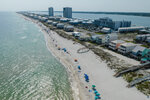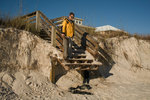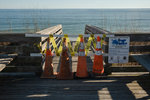GULF SHORES — Beach renourishment in Gulf Shores, Orange Beach and Gulf State Park will start in September, and $17 million worth of projects to add and enhance the shore, dunes and turtle …
This item is available in full to subscribers.
Please log in to continue |




GULF SHORES — Beach renourishment in Gulf Shores, Orange Beach and Gulf State Park will start in September, and $17 million worth of projects to add and enhance the shore, dunes and turtle protections should be done by April 2024.
Gulf Shores officials learned more about the project on Monday, July 17, from Gulf Shores City Engineer Mark Acreman, that will repair damage and degradation from Hurricanes Nate and Sally.According to the proposal, which is set to be voted on by Gulf Shores City Council at their July 24 meeting, the Gulf Shores portion would include 750,000 cubic yards of beach fill; 405,000 cubic yards of additional sand to further enhance beaches; 505,000 dune plants; 3,000 linear feet of sand fencing and Sea turtle trawling.
If approved, Acreman said, the project is estimated to last around seven months, beginning in September and ending in April 2024.
"The beach actually maintained its width and height until the hurricanes, but once you lose that width and height, beach erosion really picks up," Acreman said.
Several audience members voiced their questions about the project, citing concerns on the impact on Little Lagoon Pass and accessibility of the beach.
"We won't be putting any sand into the pass. The sand will move from east to west down the beach and will migrate and fill itself without overfilling the pass," Acreman said.
Acreman said that if approved, residents can expect the renourishment project to continue every day until the project is finished.
"We will be going 24/7 until we are done. The cost of the dredge is about $150,000 a day, so we do not stand down; we move quickly," Acreman said. "Each are should take around three to four days to complete, and any weather delays are already built into the contract."
Documents presented at the work session state that approximately 85-95% of the project costs should be reimbursed by FEMA and AEMA because the damage was caused by Hurricanes Nate and Sally. After reimbursements, the city would owe approximately $6,579,242, which would be funded through the 2% lodging tax instituted to maintain the city's engineered beaches.
"Between 2001 and 2004, the city invested approximately $18 million to construct the first engineered beach projects that are now recognized by FEMA as city infrastructure.
As long as the city periodically reinvests in renourishment projects, damages due to a declared disaster are reimbursable by FEMA/AEMA," the document reads. "The 405,000 cubic yards of additional sand included in the restoration work will insure the city maintains FEMA eligibility, provides greater storm protection, wider recreational beaches and extends the life cycle of our beach renourishment by approximately two years."
The July 24 meeting begins at 4 p.m. and is open to the public.